Due to be released during Marine Week (August 30th to September 4th in the city of São Paulo), a research synthesis from the Brazilian Coastal Marine Diagnosis on Biodiversity and Ecosystem Services is reporting disturbing news and reinforces the urgent need for taking action to restore and preserve the nation’s coastal environments. Brazil’s coastal belt, which stretches for 8,500 kilometers along 17 states, has immense biological and economic value and is the source of about 85% of the country’s oil, 75% of its natural gas, and 45% of the fish produced.
Coordinated by the Brazilian Platform for Biodiversity and Ecosystem Services (BPBES), the 20-page summary is aimed at government managers and calls attention to the loss of biodiversity and extreme degradation of the mangroves, coral reefs, beaches, and other marine and coastal environments in Brazil. Listed among the causes: pollution — from sewage, chemical waste, and plastic packaging — climate change, uncontrolled urbanization, a lack of effective public policy, and the introduction of invasive species such as the lionfish (Pterois spp.), which comes from the Indian Sea and has already decimated the young of various native species in the Caribbean.
To confront these problems, the authors of the diagnosis propose governance strategies that bring together all the various stakeholders — research institutions, government agencies, business, and civil society, including traditional communities — and promote decisions based on the best knowledge available from scientific studies or the practices of indigenous peoples and traditional communities. One example would be assessing fish stocks, through which fish catch limits could be planned, to reduce the risk of species extinction.
“We have to learn to go to the negotiation table without wanting to impose our truth, because everyone interprets the world in their own way,” stresses one of the report’s coordinators, Cristiana Simão Seixas, from the Center for Environmental Studies and Research at the University of Campinas (NEPAM-UNICAMP). “And no one can leave feeling defeated.”
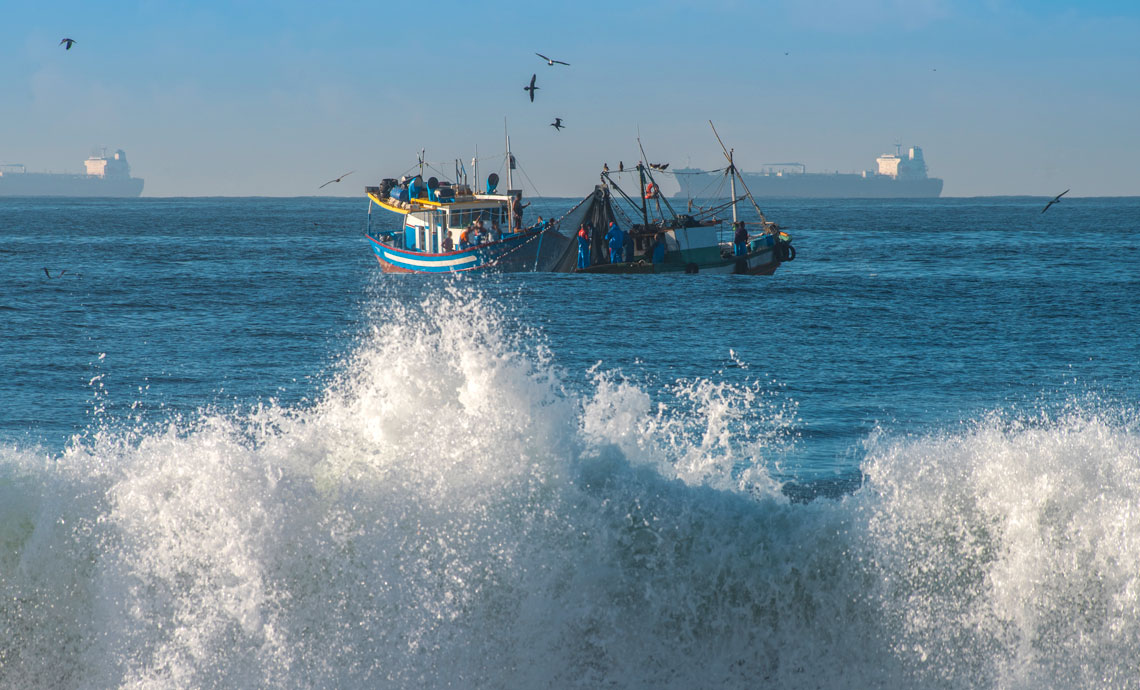
Lindrik/Getty ImagesFishing boats on the coast of Rio de JaneiroLindrik/Getty Images
Seixas believes one essential participant in the negotiations is the Public Prosecutor’s Office, whose primary function is to supervise the state, which is responsible for creating, implementing, and monitoring environmental legislation. For now, dialogue is scarce. “There is a lack of coordination between federal, state, and municipal governments around actions to protect the marine environment,” observes another of the report’s coordinators, biologist Alexander Turra, from the Oceanographic Institute of the University of São Paulo (IO-USP), and the United Nations Educational, Scientific and Cultural Organization (UNESCO) Chair for Ocean Sustainability of the Institute for Advanced Studies (IEA-USP). The full version of the study should come out by the end of this year.
Marine environments are a global concern. In March, the United Nations (UN) announced the High Seas Treaty, which would define 30% of the world’s oceans as protected areas and guarantee the conservation and sustainable use of marine biodiversity in international waters. The UN had already launched the Decade of Ocean Science for Sustainable Development (2021–2030) in 2017 to increase scientific research and support the integrated management of oceans and coastal zones.
These international initiatives have revived Brazilian plans for conserving the marine environment, brought research groups closer together, and motivated new guidelines, such as the National Plan for Implementation of the Decade of Ocean Science for Sustainable Development, launched in December 2021 by the Ministry of Science, Technology, and Innovation (MCTI).
In addition to making their diagnoses, the researchers also contribute to problem solving. One good example of this collaboration is a case that began in the 2010s in the village of Trindade, in Paraty prefecture, on the coast of Rio de Janeiro. Tour boats were accustomed to freely bringing tourists to a natural pool in the Serra da Bocaina National Park area. After several conflicts, the Chico Mendes Institute for Biodiversity Conservation (ICMBio) required that the tour boat operators take training courses before then signing a contract that would permit them to legally operate in the park. Natália Bahia and Paula Chamy da Costa, researchers from Seixas’s team working in the area with support from FAPESP, prepared three of the five required courses and helped mediate the conversations between ICMBio and the Association of Boatmen and Fishermen of Trindade (ABAT). The boat operators met the park’s requirements, took the courses, and in 2020 received formal authorization to bring tourists. “I went back there in February and everything was working fine. The tour guides were well organized, uniformed, and all the boats had safety equipment,” the biologist says.

Giogomes/WikimediaDry mangroves in Jericoacora, in CearaGiogomes/Wikimedia
Turra, likewise, coordinates research supported by FAPESP that has resulted in a proposal to restructure the methods beaches are utilized on the north coast of São Paulo, taking into consideration not only tourism but also food production for local communities and protection against erosion.
A broad range of ocean research is being conducted in the state of San Paulo. Studies vary from the scientific classification of marine organisms conducted by biologists Cecília Amaral from the University of Campinas (UNICAMP) and Paulo Sumida, from IO, to research on conservation strategies. Researchers from São Paulo institutions have participated in describing previously unknown marine environments, such as the mouth of the Amazon River, the deepwater reefs off the coast of Espírito Santo, and a bank of rhodoliths (calcareous algae) covering five square kilometers on the coast of São Paulo. The oceanographic research vessels Alpha Crucis and Alpha Delphini, together with the IO-USP bases in Ubatuba, on Sao Paulo’s north coast, and Cananeia, on its south coast, serve biologists, oceanographers, geologists, chemists, and other specialists from state and federal universities and research institutes.
Since 1993, FAPESP has supported nearly 1,100 ocean research projects, usually in connection with programs such as Biota and the Research on Global Climate Change project. “It’s a very important topic,” comments Marco Antonio Zago, president of FAPESP’s Board of Governors. “We’re convinced that we need to be doing more research on the marine environment, because of its implications for biodiversity, human occupation, oil exploration, and climate change.”
Virtually the entire Exclusive Economic Zone (EEZ) of Brazil, the area extending 370 kilometers out to sea along the coast, totaling 3.6 million square kilometers, is presented with at least one type of listed threat to the balance of the marine environment. The most dramatic transformations are found in the port regions of the Northeast, Southeast, and South and at the mouth of the Amazon River, which has become an area of intensive fishing in recent years.
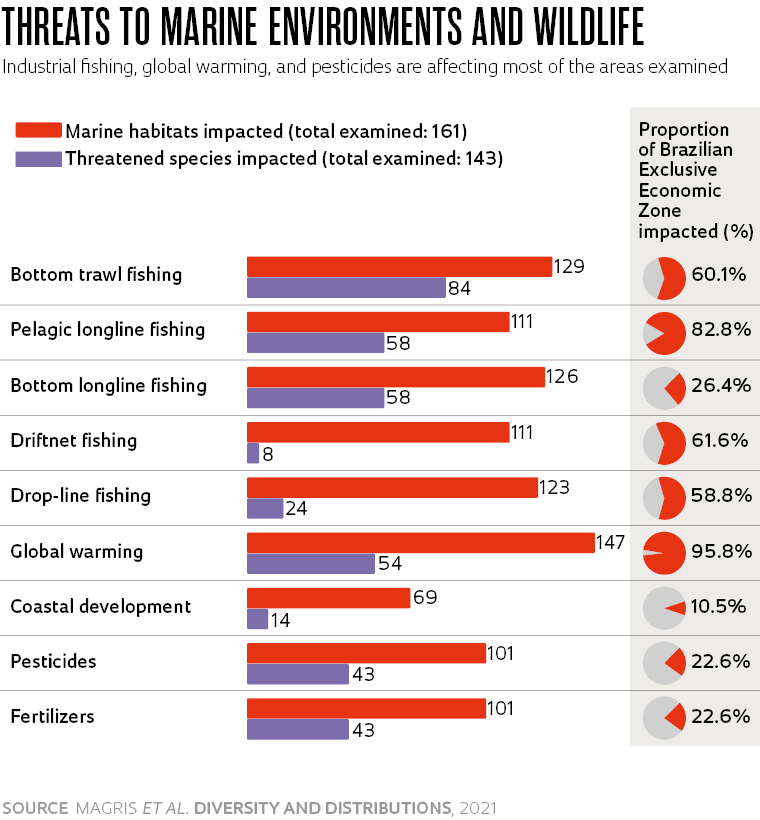
These are the conclusions of a study published in November 2020 in Diversity and Distributions, coordinated by oceanographer Rafael Magris, from ICMBio. Magris examined the effects of environmental pressure from 24 human activities — including industrial fishing, the use of agricultural fertilizers that drain into the sea, and pollution from ports and oil extraction — in 161 habitat sampling areas along the Brazilian coast, from Amapá to Rio Grande do Sul, and on 143 species of marine animals (including invertebrates, fish, mammals, reptiles, and birds) classified as critically endangered, threatened, or at some risk of extinction.
Almost every analyzed area (95%) showed changes the researchers attributed to global warming, while 60% to 83% of the areas showed damage from different types of nets used by large fishing boats, and 22% of the areas were affected by fertilizers and pesticides employed in agricultural activities. Although still a nascent industry, seabed mining — mainly for calcareous algae used to correct soil acidity — impinges on 63 of the 161 habitat sample sites examined (see infographic). These pressures accelerate the transformation of coastal environments and reduce their ecological function (reproduction capacity for fish and crustaceans, for example), increasing the risk of reduction in fish stocks and other groups of animals.
Data from this study was the basis for a proposal to establish new marine conservation areas at the mouth of the Amazon River, at the southern part of the Abrolhos archipelago (southern Bahia), and for the deep-sea coral reefs. Currently, only 2.5% of Brazil’s EEZ area enjoys complete protection, where fishing is prohibited. “We haven’t created any regulated, fully protected marine sanctuaries, such as national parks and biological reserves, for decades,” observes biologist Ronaldo Francini-Filho, from USP’s Center for Marine Biology (CEBIMar), who participated in the study.
During observation dives in the region of Abrolhos, on the coast of Bahia, from 2001 to 2008, the researcher recorded a drop of approximately 50% in the population of blue wrasses (Scarus trispinosus) with body-lengths up to 90 centimeters in length. They were put on the endangered species list in 2014.
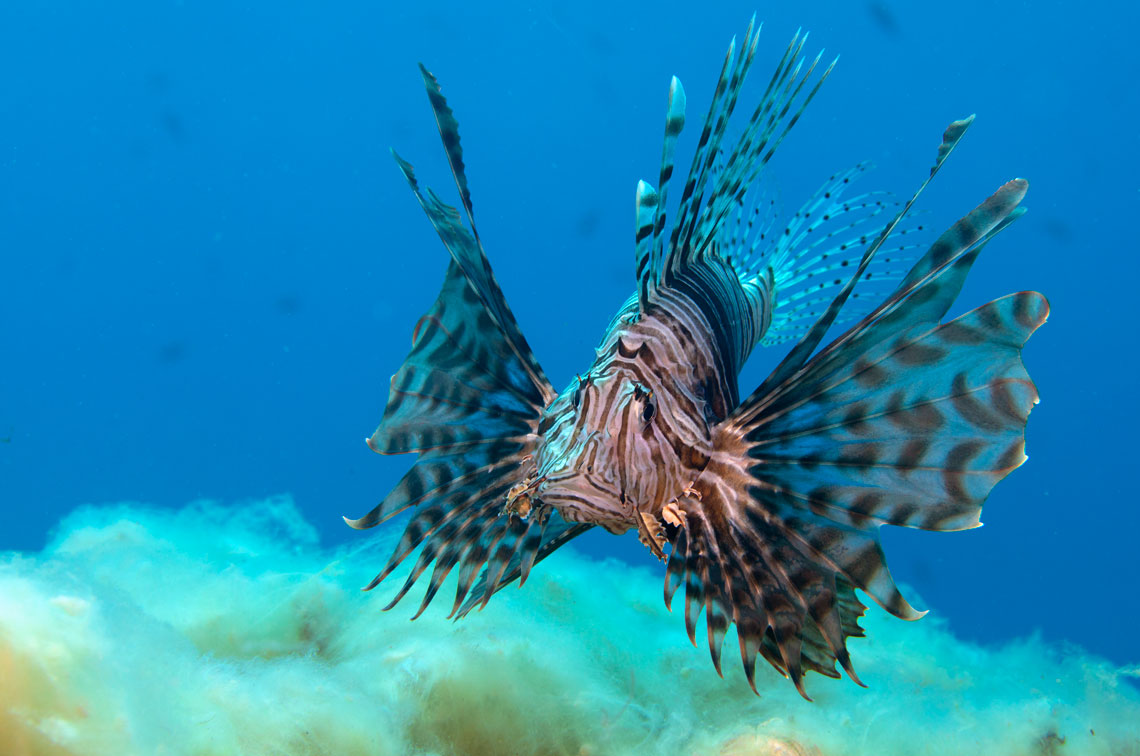
Mahmut Serdar Alakus/Anadolu Agency via Getty ImagesLionfish, invasive species that occupies more space on the Brazilian coastMahmut Serdar Alakus/Anadolu Agency via Getty Images
“Climate change makes everything more complicated,” said oceanographer Vanessa Hatje, from the Federal University of Bahia (UFBA), speaking at the Diálogos da Cultura Oceânica, a congress held by the Federal University of São Paulo (UNIFESP) in October 2022, in Santos, São Paulo. The rise in annual average ocean temperatures could intensify acidification, reduce water oxygen levels, and contribute to sea level rise, in addition to altering the impacts of pollutants on the global marine environment, according to a study Hatje coordinated with colleagues from India, Germany, Chile, and the UK, published in July 2022 in Frontiers in Marine Science.
The Brazilian coast may already be showing the effects of climate change. “After a sharp increase in the average temperature in 2019 — the most acute since 1985 — we saw bleaching [loss of color] and high coral mortality,” observes biologist Bárbara Pinheiro, from the Costa dos Corais Long Duration Ecological Project (PELD), which was based on surveys carried out in 2018, 2019, and 2020 along 120 kilometers of an environmental protection area between Pernambuco and Alagoas. According to a study published in May 2022 in Frontiers in Marine Science, the population of fire coral (Millepora braziliensis) suffered a 50% reduction, while cauliflower coral (Mussismilia harttii), which helps form other corals, decreased by 32%.
“The risk of sea encroachment on urban areas will be higher if we destroy or lose the reefs because they form natural barriers that help to reduce the force of the waves,” says biologist June Ferraz Dias, from IO-USP. With support from FAPESP, Dias is studying the distribution of fish communities in the waters surrounding Anchieta Island, an environmental protection area on the north coast of São Paulo. On her first trip, in May, the trawler net that ran along the sea bottom came up with about 15 kilos of plastic waste. “It was scary,” she said.
Guanabara Bay, in the Metropolitan Region of Rio de Janeiro, has different problems. The number of exotic species has increased and the distribution of various groups of marine animals has changed, according to research by the Federal University of Rio de Janeiro (UFRJ). Both in Rio and the bay of Todos os Santos, in Bahia, populations of an Indo-Pacific oyster (Saccostrea cucullata) have proliferated while those of a native species (Crassostrea rhizophorae) have decreased, “but not in the same locations, which indicates that it’s not a question of competition, but an effect of the increase in the average water temperatures,” says biologist Paulo Cesar de Paiva, from UFRJ. “The native species is less resistant to higher temperatures than the exotic species.”
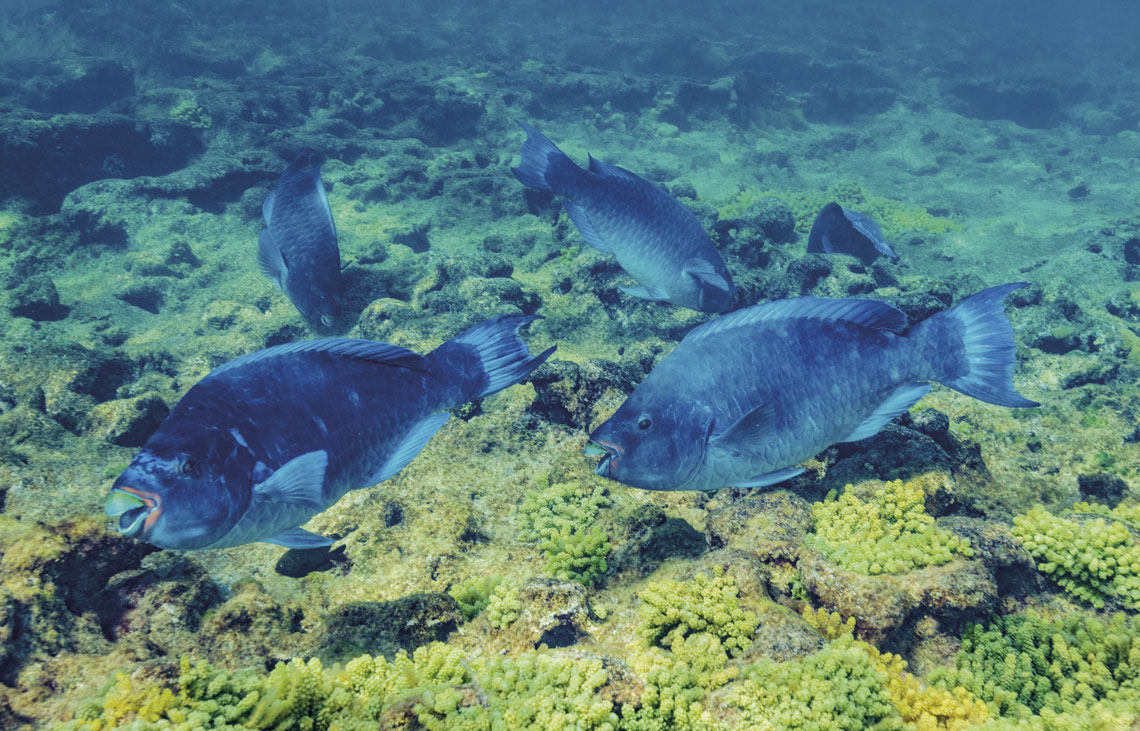
Robertocostapinto/WikimediaA blue wrasse, listed as threatenedRobertocostapinto/Wikimedia
This is not the only problem in Guanabara Bay. Heavy metal residues, petroleum, and unprocessed oil that leak from ships pollute both the water and the mangroves, which, if preserved, could help mitigate the effects of global warming, since the muddy bottom stores organic material. “The best thing we can do is not disturb the mangroves, so as not to release carbon stocks into the atmosphere and exacerbate the effects of climate change,” recommends Hatje (see article on the website titled “Planícies associadas às florestas de mangue retiram carbono da atmosfera” [Mudflats associated with mangrove forests remove carbon from the atmosphere]).
Meanwhile, on the Ceará coast, the mangroves are expanding due to the advance of seawater and an increase in salinity. “The dams on the rivers built to form reservoirs further reduce the fresh water in the estuaries and facilitate the sea’s entry,” explains Hortência de Sousa Barroso, a biologist from the Federal University of Ceará (UFC), who is a member of another project in the network of 11 marine coastal PELDs supported by the National Council for Scientific and Technological Development (CNPq).
In the bay of Paranaguá, on the coast of Paraná, chemist César de Castro Martins, from the Federal University of Paraná (UFPR), found what are known as “emerging contaminants,” i.e., residues of perfumes and sunscreens used by residents and tourists from cities along the coast. Researchers from Pontal do Paraná, Salvador, and the state of São Paulo detected higher levels of personal care products in sediment samples taken in well-preserved areas of the Atlantic Rainforest — an apparently paradoxical result, but explained by water circulation and increased tourism. On the other hand, “the best environmental indicators are in areas with the lowest socioeconomic indicators,” Martins says, confronting a challenging situation: “We have to improve our people’s quality of life while at the same time maintaining a healthy environment.”
Scientists and public managers evaluate the best way to apply research results
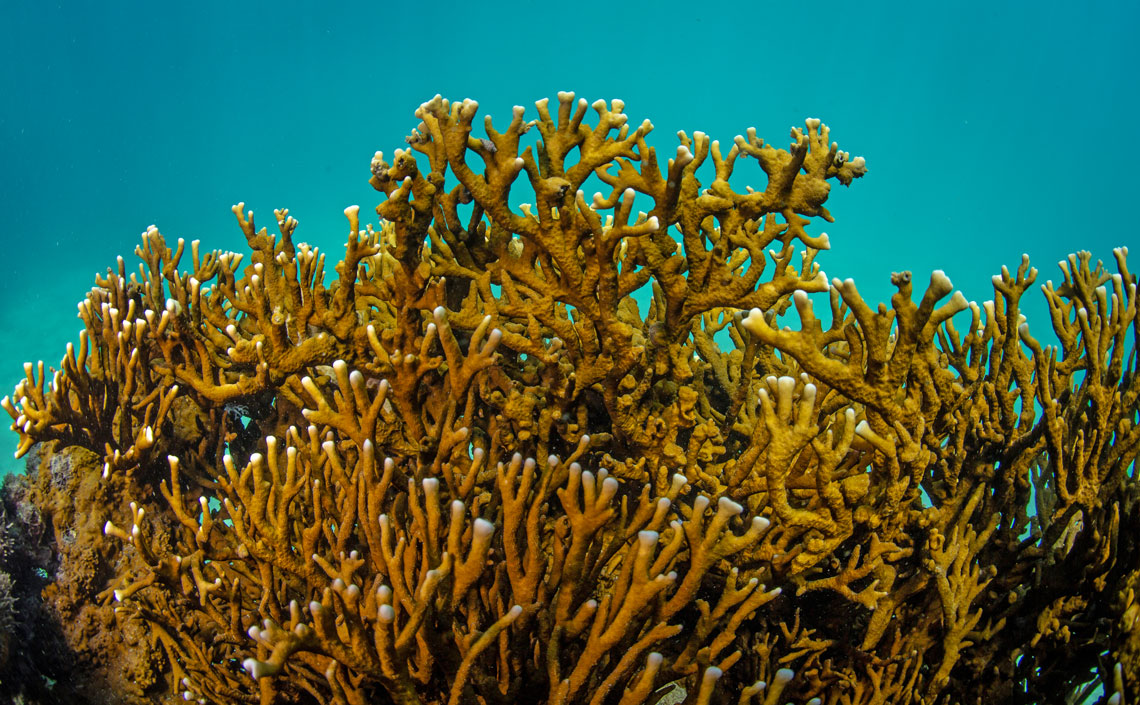
Jonne Roriz/Nosso ImpactoA colony of coral and an aerial view in the Costa dos Corais Environmental Protection AreaJonne Roriz/Nosso Impacto
In 1993, biologist Beatrice Padovani Ferreira and oceanographer Mauro Maida, both from the Federal University of Pernambuco (UFPE), working together with other researchers and ICMBio’s Northeast Marine Biodiversity Research and Conservation Center (CEPENE), began monitoring populations and the environments of corals, fish, and other communities of marine organisms on the coast near Recife. The need to create protected areas had become imperative due to the reduction in fish stocks.
A variety of studies and consultations with local residents formed the basis for establishing the Costa dos Corais Environmental Protection Area (APACC) in 1997, a 2,95 square kilometer area in Tamandaré, on the southern coast of Alagoas state. The APACC is the largest coastal-marine conservation unit in Brazil, providing the legal basis for regulating the use and conservation of the region’s reefs.
This region functions as a refuge for maintaining populations of commercially valuable fish species, which also migrate to neighboring areas, according to a study the research group published in April 2022 in the Marine Ecology Progress Series. Other studies have emphasized the importance of connectivity between these marine environments and indicate that protecting only one type of space may not be enough.
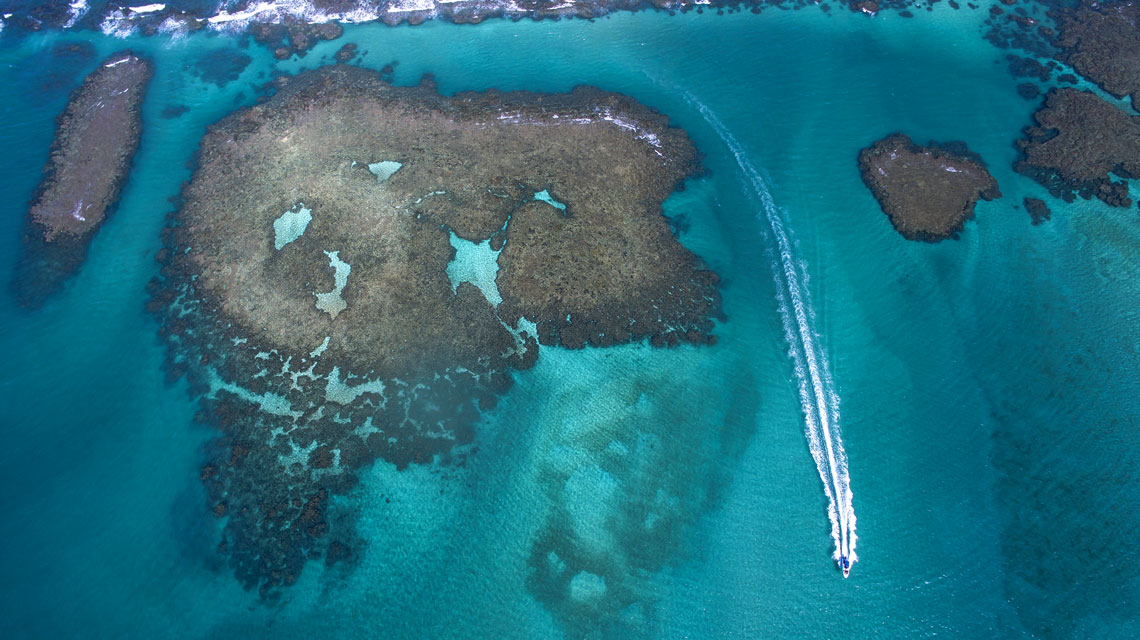
Jonne Roriz/Nosso ImpactoAerial view of the Costa dos Corais Environmental Protection AreaJonne Roriz/Nosso Impacto
“The juvenile forms of dogtooth snapper (Lutjanus jocu) and mutton snapper (Lutjanus analis), highly valued by fishermen, live in shallow areas, but migrate throughout their lives and form groups of hundreds of fish in deep areas during reproduction,” says Ferreira. “ICMBio is considering expanding the APACC because the deeper regions are outside its borders.”
The researchers have been in discussions with public prosecutors, mayors, and other representatives of government agencies so that their studies can help in environmental recovery. And, as their work becomes better known, they are being called on by government teams to participate in planning conservation units.
In July 2022, a research group from UFRJ, with support from the city of Macaé, Rio de Janeiro, called on students, teachers, and other volunteers to plant native species, fence the preservation areas, and install signs where invasive species had been removed. Their goal is to restore the area’s restinga, a native scrub-forest formed by low and spindly trees, through which course streams of copper-colored water. The researchers have been monitoring changes in the region for 22 years. They report that — mostly since 2016 — the number of invasive species of mammals and grasses has grown by 30% and invasive freshwater fish have increased by 20%, a result of the reduction in forested areas caused by the construction of oceanfront houses.
In December, geologist Rodolfo José Angulo, with his UFPR team, spoke with the municipal managers and residents of Ilha do Mel, the second largest tourist center in Paraná after Foz do Iguaçu, to present the results of his team’s studies in the region and promote environmental recovery measures. In 2022, after examining the circulation patterns of domestic waste in the bay of Paranaguá, the researchers built two sewage treatment systems, with biodigesters and waste-filtering using roots, stones, and sand, for the island’s two schools. Angulo notes that before the installation, when it rained the septic tanks would fill up, and sewage overflowed into the classrooms.
Projects
1. Promoting beach conservation and spatial planning through an ecosystemic approach (nº 18/19776-2); Grant Mechanism Research Grant – Biota Program; Principal Investigator Alexander Turra (USP); Investment R$243,097.82.
2. Spillover effect of Protected Marine Areas:An assessment inside and outside fishing exclusion areas near Conservation Units (nº 20/00046-4); Grant Mechanism Research Grant ‒ Biota Program; Principal Investigator June Ferraz Dias (USP); Investment R$179,816.26.
3. Diversity and evolution of deep ocean fish: (nº 17/12909-4); Grant Mechanism Research Grant ‒ Biota Program ‒ Junior Researchers; Principal Investigator Marcelo Roberto Souto de Melo (USP); Investment R$1,021,570.91.
4. Becool (nº 19/12551); Grant Mechanism Research Grant ‒ Global Climate Change Research Program – Thematic; Principal Investigator Paulo Yukio Gomes Sumida (USP); Investment R$208,113.01.
5. Integrated approach to the sustainable prospecting of natural marine products: From diversity to anticancer substances (nº 15/17177-6); Grant Mechanism Research Grant ‒ Biota Program; Principal Investigator Leticia Veras Costa Lotufo (USP); Investment R$3,747,697.53.
6. Natural resource management in socioecological systems: Integrating environmental conservation and local development (nº 15/19439-8); Grant Mechanism Research Grant ‒ Biota Program; Principal Investigator Cristiana Simão Seixas (UNICAMP); Investment R$170,706.00.
Scientific articles
HATJE, V. et al. Emergent interactive effects of climate change and contaminants in coastal and ocean ecosystems. Frontiers in Marine Science. vol. 9, 936109, pp. 1–8. july 25, 2022.
LIPPI, D. L. et al. Use of acoustic telemetry to evaluate fish movement, habitat use, and protection effectiveness of a coral reef no-take zone (NTZ) in Brazil. Marine Ecology Progress Series. vol. 688, pp. 113–31. apr. 28, 2022.
MAGRIS, R. A. et al. A blueprint for securing Brazil’s marine biodiversity and supporting the achievement of global conservation goals. Diversity and Distribution. vol. 27, no. 2, pp. 198–215. nov. 1, 2020.
PEREIRA, P. H. C. et al. Unprecedented coral mortality on southwestern Atlantic coral reefs following major thermal stress. Frontiers in Marine Science. vol. 9, 725778, pp. 1–12. may 20, 2022.
TALWAR, B. S. et al. Extinction risk, reconstructed catches and management of chondrichthyan fishes in the Western Central Atlantic Ocean. Fish and Fisheries. Online. apr. 30, 2022.
